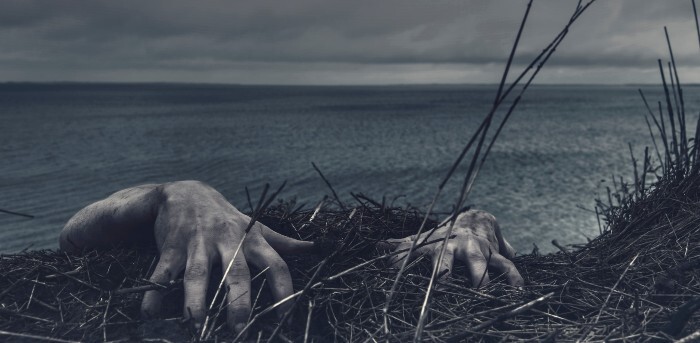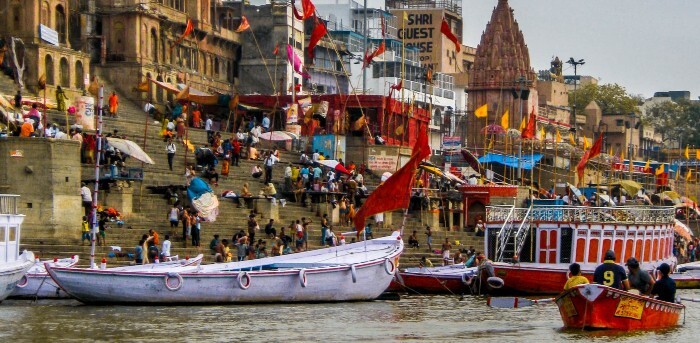15 Eyebrow-Raising Death Rituals Around the World

When you think about it, it’s pretty strange to dress up in a specific color and throw our loved ones in a hole in the death garden. In that respect, there’s nothing necessarily wrong with, say, leaving the dearly departed out to be brutally scavenged by animals or throwing the kind of lavish party we usually reserve for weddings, but it does raise some modern western eyebrows.
Sky Burial

Sadly, sky burials have nothing to do with postmortem skydiving. It’s the Tibetan practice of chopping up a body into little pieces, waiting for vultures to eat the flesh, and then smashing the bones until there’s nothing left. It’s more practical than traditional burial, because the soil in Tibet tends to be too hard and cold, and certainly less wasteful.
The Indonesian “Walking Dead”

For the Toraja people of Indonesia, death is less of an event than a process, which can take years, until “the extended family can agree upon and marshal the resources necessary to hold a funeral ceremony.” In the meantime, the deceased is considered merely “sick” or “asleep” and cared for much like a sick person would be, including being served meals. Once everyone agrees they’re dead, the body is walked through town to their grave, a sight many foreigners have mistaken in a panic for the zombie apocalypse.
The Tinguian “Smoking Dead”

The Tinguian people of the Philippines also live with their departed loved ones for some time, but they do it in style. The dead are dressed in their finest clothes and seated in a chair for several weeks after death, often with a cigarette in their mouths, because every smoker knows the value of one last puff.
Self-Mummification

It’s been outlawed since the 1800s, but successful self-mummification was believed to result in Buddha-hood, so it was popular among a certain sect of Japanese Buddhists. It took 2,000 days of starving, drying, and preserving your own body, but that’s a small price to pay for enlightenment.
Famadihana
Every five to seven years, some ethnic groups of Madagascar dig up their dead to party down with them in a ritual called Famadihana. They give them a nice new shroud, update them on what’s been going on since they’ve been gone, and carry them above their heads while they dance ‘til dusk, when the bodies are reburied with gifts of money and booze. After all, where’s the fun in a sober afterlife?
India Death Parades

In Varanasi, India, where hundreds of Hinduists are cremated every day with the belief that the sacred city will free them from the cycle of reincarnation, bodies are first carried through the streets dressed in colors that symbolize the deceased’s best qualities. It’s not much different from our funeral processions, except a bit more open air and colorful.
Nigeria Trials and Ingurgitations

Igbo funeral customs are vast and complex, often including mock trials to determine who was responsible for the deceased’s death, even if they weren’t murdered. A relative also spends a day eating the departed’s favorite meals, which ensures they have enough food in the afterlife and is also just a nice way to remember someone.
Mortuary Totem Poles
Some indigenous tribes of the Pacific Northwest paid tribute to their high-ranking members by storing their bodies in a box at the top of a totem pole. It’s much like displaying an urn of ashes in your home, just somewhat smellier, according to foreigners’ accounts.
Ghana Fantasy Coffins
People in Ghana believe the dead continue their jobs in the afterlife, so they’re often buried with objects and in coffins representing those jobs, particularly made by a renowned group of coffin makers who have turned themed death boxes into an art. They’re sought after even by people outside Ghana, including Jimmy Carter, whose coffin will presumably be a giant peanut.
Caviteño Trees

The Caviteño people of the Philippines don’t get buried in a coffin at all but vertically in a hollowed-out tree trunk that they’ve chosen for themselves, which seems like a lot of pressure. Sure, plenty of people pick out their own coffins, but what if you have no affinity for any particular tree? It’s hard enough being terminally ill -- now you’ve got to pick a favorite tree?
Nordic Deaths Ships

The iconic image of a Viking funeral is a body shoved off in a boat that’s set on fire by a flaming arrow, but a funeral pyre and a ship burial were usually two separate things. It was more common to just set the ship loose, thoroughly unburnt, for an unwitting sailor to have the misfortune to happen upon. Even more often, because those big ships are expensive, people were simply buried with their boats.
Pennsylvania Funeral Pie

It sounds like a euphemism you’d find on Urban Dictionary, but funerals were one of the few times the Amish could really live it up, featuring lavish feasts that often included a special raisin pie, since raisins were considered a luxury (it was a grim time indeed). The custom has largely fallen out of favor, and the Amish youth often don’t understand the significance of presenting someone with a raisin pie, resulting in a lot of insulted old folks.
Sweden Death Candy
Meanwhile in Sweden, the funeral food was considerably tastier but also infinitely more hardcore. In the 19th century, mourners were given hard candy in the shape of a corpse wrapped in black paper, because Sweden will never, ever let you forget how metal they are.
Suttee
It’s since been outlawed, but it used to be considered “the ideal of womanly devotion” for a widow to join her husband on his funeral pyre, to the point that if she chickened out, she would often be “helped” back in. It was probably largely because being a widow in India sucked so bad back then it was honestly preferable to burn yourself alive.
Taiwan Funeral Strippers

In Taiwan, the number of people who attend your funeral is all important because it determines the quality of your afterlife, and what gets the crowds a-flocking like titties? Since way back in the late 1800s, strippers have been paid to entice the otherwise uncaring to get in the mourning spirit. In 2017, one politician’s funeral was heralded by as many as 50 pole-dancing young ladies. Has anyone told Kid Rock about this? If so, his funeral is gonna rule.
Top image: The Good Funeral Guide/Unsplash